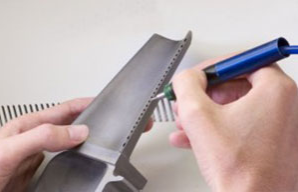 Microblasting is a safe and effective application for aeronautic processes.
Microblasting is a safe and effective application for aeronautic processes.
Aeronautic parts require high-quality processes of manufacturing in order to ensure reliability and long tifetime of systems.
– Helices of turbines
Microblasting is used in manufacturing helices of turbines to clean holes drilled with lasers.
The operation is also part of turbine helices maintenance.
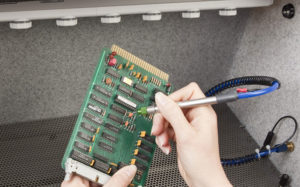 Protective coatings belong to the category of plastics and other resins that are applied to electronic devices to protect them from various contaminations.
Protective coatings belong to the category of plastics and other resins that are applied to electronic devices to protect them from various contaminations.
In some cases this coating must be removed completely or on specific areas for various reasons: component failure, clearing of test points or when used devices are returned for repair.
– Microblasting: the most suitable method for removing coating from printed circuit boards
Thanks to microblasting, coating removal is fast and efficient. It takes place in a controlled environment and is easy to use.
Selective removal on the periphery of a component provides total control and prevents damage to adjacent components. As these stripping operations are simple to perform, they can be carried out by unqualified personnel.
– Advantages of microblasting compared to other methods:
Protective coatings can also be removed mechanically, thermally or chemically, but these methods have disadvantages that microblasting does not have:
– Mechanical methods (scraping, grinding...) require very experienced operators, otherwise this process can cause irreparable damage to components.
– Some coatings can be burnt with a soldering iron. This method is quick but there is a risk of damage to the devices. Moreover, some types of coatings treated in this way can generate fumes that are toxic to the operator.
– Chemical stripping is effective for some types of varnish but it involves rather long process times. The chemicals can get underneath the components, creating bubbles under the protective varnish. In addition, safety and environmental restrictions on chemicals create additional constraints.
– How it works:
The printed circuit boards are handled in the blasting chamber, which is specially designed for this function.
To start the blasting operation, the operator operates a foot switch pedal, which is connected to the microblaster.
While the operator directs the nozzle to the area to be worked on, the sanding beam selectively cuts the varnish.
The workstation, equipped with the anti-static control system (ESD), confines the particles during sand-blasting.
Different types of powders can be used depending on the desired result:
– Walnut shell
– Plastic media
– Sodium bicarbonate
These powders have unique characteristics, thanks to their specific granulometry.
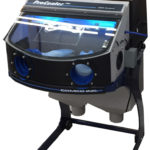
– Quality control and electrostatic discharges:
Originally, varnishes were used for rigorous military (or tropicalized) applications.
These same strict requirements are applied to the coating removal methods, as it is a safe process and the results provided by microblasting are obvious, conclusive and reliable.
Microblasting is the recommended process used by many military departments and their subcontractors for paint stripping, railways and metropolitan areas also use it.
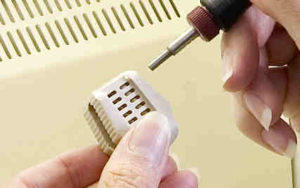 – Catheter/Wireway
– Catheter/Wireway
Microblasting is currently used in catheter manufacturing to remove polymer coatings on selected small areas and to remove PTFE (Polytetrafluoroethylene) coatings on wireways. The process is also very effective in preparing surfaces to facilitate the adhesion of a coating.
Ideal abrasive : Sodium bicarbonate, with its cutting action and water solubility, is the most suitable abrasive for this type of application.
– Peek Implant / Hypodermic Needles / Tubular Components for Stent Fabrication
During the moulding process of a tube, a burr called "heel burr" forms and must be removed. Laser-cut holes or slots in the tube must also be deburred.
Ideal abrasive : Aluminum oxide and glass beads are the most effective abrasives for this type of application.
– Vascular stents
The stent manufacturing process generates deposits of unwanted material on the device. Oxidation and discoloration may also result from the process. Microblasting is used by manufacturers to remove these deposits without damaging the device.
This is done prior to the application of special coatings.
Ideal abrasive : Aluminum oxide and silicon carbide are usually used to work on stents.
– Implantable devices
Bone screws, plates and implantable prostheses often have holes or slots, which are difficult to deburr with conventional means and easy to deburr with the microblaster.
A texturing operation can be applied to these devices, for example to promote tissue growth around the implant. Microsandblasting allows this operation to be carried out with precision and repeatability.
Ideal abrasive Silicon carbide, aluminium oxide and glass beads are the abrasives generally used for microsandblasting on this type of device.
– Medical castings
Injection moulding is used to manufacture a wide range of medical devices and disposable components. The tooling required to perform the moulding process is expensive and the mould cavities require regular maintenance.
Microsandblasting is used to clean and restore device surfaces without changing the dimensions of the cavities. In addition, the microblaster can also be used to remove EDM residues and for texturing the surface of a new mould.
Ideal abrasive : Crushed glass, crushed nut shells, glass beads, and plastic media are all abrasives used for mold cleaning; aluminum oxide and silicon carbide are used for cavity texturing.
– Electronic medical devices
Electronic components are frequently used for diagnostic or surgical instruments and also for implantable devices such as pacemakers and defibrillators.
Microblasting is used to precisely remove a silicone insulation and thus expose an electrical conductor on defibrillators. It is also effective in removing excess encapsulation material on pacemakers.
Diagnostic devices and surgical instruments contain printed circuit boards that have a conformal coating to protect the components from environmental conditions. Replacement of a defective component is often necessary. Microblasting can selectively remove part of the coating in order to remove and replace the affected component.
Ideal abrasive : Sodium bicarbonate is frequently used for electrical devices. Plastic and crushed nut shells are also very effective abrasives for coating removal on these devices.

– Others
Vascular prostheses, ophthalmic surgical instruments, hernia clips, vascular plate removal devices, contact lens molding, orthodontic coupons and bands...

Microblasting is ideally suited for applications in the precision industry.
– Deburring of Swiss precision machined parts
Burrs left by the machining process must be removed.
Angled nozzles are often used to deburr openings on complex components such as waveguides and manifolds.
– Removal of residues from the EDM process
The EDM process leaves a lead residue on the substrate that can be effectively removed with microsandblasting.
– Finishing an injection molded cavity
Whether following laser treatment, EDM or other methods, the surface of a molded cavity requires a finish to prevent the plastic from sticking. Microsandblasting is an effective technique for finishing cavity surfaces without damaging the shape of the mold.
– Nozzle cleaning
Like all moulded cavities, nozzles are subject to residue build-up. Manual cleaning must be done carefully as the nozzles can easily be damaged. Microblasting is an effective method for removing residues with high precision and increases the service life of the nozzles.

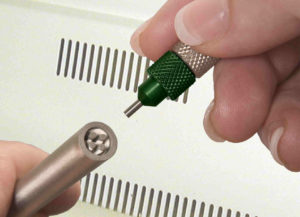 Microblasting is performed to remove insulators made of magnesium oxide
Microblasting is performed to remove insulators made of magnesium oxide
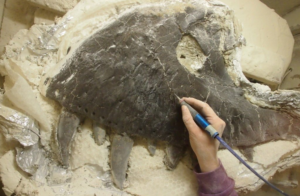 Comco microblasters have been used by renowned museums for the preparation of Tyrannosaurus fossils and also by craftsmen and amateurs to clean trilobites, crinoids, ammonites and other fossils.
Comco microblasters have been used by renowned museums for the preparation of Tyrannosaurus fossils and also by craftsmen and amateurs to clean trilobites, crinoids, ammonites and other fossils.
– Fossil preparation
Microblasting is widely used to remove the obstructing coating on an embedded fossil, thus to bring out its relief and pattern. Large amounts of material must be removed to expose the fossil and damage to it must be avoided.
Microblasting is effective because it allows a fossil to be cleaned with the necessary precision to avoid possible damage to the specimen.
